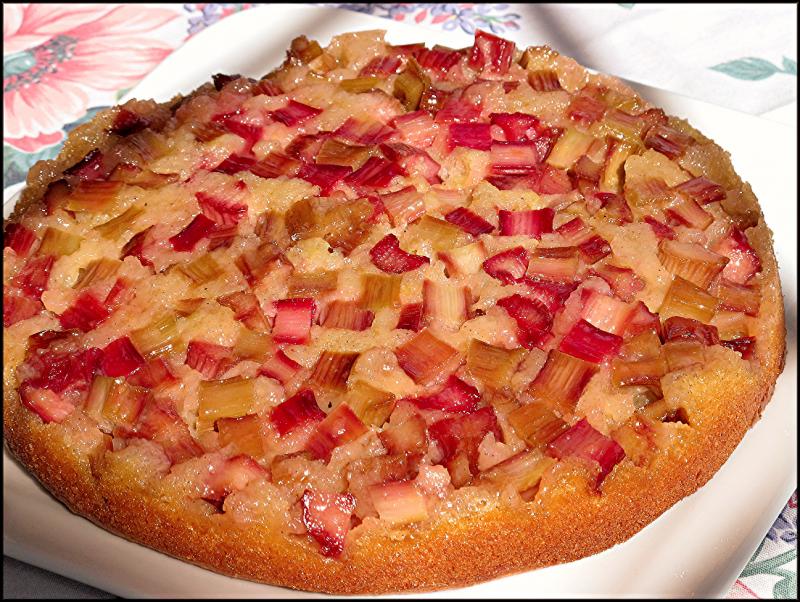An introduction to rhubarb and its surprising uses
Once again, the appearance of rhubarb stalks in the produce aisle at Lloyd’s Market tells us spring is truly here. With a short season that runs from late April to early June, most rhubarb can be recognized by its signature color of bright pink. You’ll also find stalks in shades of green to lighter pink, which is not an indication of ripeness or readiness to harvest, but of their variety. When offered for sale, the stalks have been stripped of their poisonous, crinkled, heart-shaped leaves.
Rhubarb grows from underground rhizomes that thrive in colder climates, including where it originated in Siberia. The Latin name comes from the Romans, who observed it growing along the banks of the river Rha (now the Volga). Since that area was considered foreign or barbarian territory at the time, its name rha barbarum translates as “from the barbaric Rha.”
Although some of the inedible, wild varieties have been used in traditional Chinese medicine for thousands of years, the succulent garden variety was only considered a desirable food during the past few centuries. Marco Polo is credited with bringing the useful medicinal plant to Europe in the 13th century. By the 1600s, England was cultivating rhubarb, the price of which was three times the price of opium.
Always a familiar sight in cottage gardens, as well as commercial farms in Yorkshire, England, rhubarb has made a comeback in recent years. A heritage crop of the Wakefield and Leeds region, this designer rhubarb (called Traditionally Grown Yorkshire Indoor Rhubarb) is now the focus of an annual festival, and the specially designed, indoor growing sheds have become a tourist attraction.
While botanically considered a vegetable, rhubarb is legally considered a fruit, as decided in a 1947 New York court case that based its ruling on how rhubarb is prepared (and perhaps because an importer successfully lobbied the cause to reduce their tax liability). But, if you look at how rhubarb is used, its classification as a fruit seems fair.
Because of its almost stringy quality when raw and its tender juiciness when cooked, rhubarb is most often used as a pie filling or made into jam. Its sharp flavor is only mellowed by lots of sugar and some time baking in the oven or simmering in a saucepan. I wanted to do something a little different with the rhubarb I’d bought, and I started looking for inspiration.
In the May & June 2021 edition of Cook’s Illustrated, there was an article by Steve Dunn which painstakingly outlined his process for perfecting a recipe for rhubarb upside-down cake, adapted from a 2019 recipe for an apple upside-down cake. He outlines his several attempts, and shares his ingredient choices and final recipe.
I continued my search and found a recipe from Food Network that sounded very similar, with a few tweaks. Geoffrey Zakarian added honey as a sweetener, selected cinnamon and ginger as seasonings, and threw in the most unlikely two teaspoons of thyme leaves. The final surprise was the use of a boxed cake mix.
Comparing the two, I opted to use Dunn’s recipe as my starting point. I liked the choice of cardamom to subtly flavor the cake and his clever addition of cornstarch to help the rhubarb juice thicken. I also agreed with his choice to line the pan with parchment paper, making it easier to remove the cake. I didn’t add his third layer of crunchy almond streusel that would end up as the base of the cake, and I omitted a glaze of melted red currant jelly. In the event you’d like to see the two options, I’ve included my adaptation of the Cook’s Illustrated version as well as the Food Network recipe.
Rhubarb Upside-Down Cake*
3/4 C sugar
1 1/2 t cornstarch
1 t grated lemon zest
1 lb rhubarb, cut into 1/2-inch pieces
2 T melted butter
1 C flour
1 1/2 t ground cardamom
1 t baking powder
1/2 t salt
3/4 C sugar
2 eggs
6 T melted butter
1/2 C sour cream
1 t grated lemon zest
1 T lemon juice
1 t vanilla extract
Streusel [optional]
1/2 C flour
1/2 C sliced almonds
1/4 C sugar
4 T melted butter
pinch salt
Preheat oven to 350 F. Spray an 8-inch square or 9-inch round baking pan with nonstick cooking spray. Line the bottom of the pan with parchment paper and coat with butter; set aside. In a small bowl, combine the sugar, cornstarch, lemon zest and chopped rhubarb. Pour in the melted butter and stir until evenly coated. Spread mixture evenly in the prepared pan; set aside. In a small bowl, combine the flour, cardamom, baking powder and salt; set aside. In a large mixing bowl, whisk together sugar and eggs until thickened and smooth. Whisk in melted butter; add sour cream, lemon zest, juice and vanilla, stirring until smooth. Add the dry ingredients and mix just until combined. Pour evenly over the rhubarb mixture. If adding streusel, mix together remaining ingredients and scatter over the batter. Bake until a tester comes out clean, about 50 minutes. Allow to cool on a rack for 20 minutes, then invert onto a serving platter. Yield: 8 servings. *Adapted from Cook’s Illustrated.
Rhubarb Upside-Down Cake*
6 C sliced rhubarb
3/4 C sugar
1/4 C honey
1 T lemon juice
2 t thyme leaves
1/2 t ground ginger
1/2 t cinnamon
1/4 t salt
1 t vanilla bean paste
1 box yellow cake mix
Preheat oven to 350 F. Coat the inside of a 9-inch pan with nonstick cooking spray; set aside. In a bowl, combine rhubarb, sugar honey, lemon juice, thyme, ginger, cinnamon, salt and vanilla bean paste. Cover and steep at room temperature for 1 hour. Spread the rhubarb mixture in the bottom of the prepared pan, reserving half the juices. Prepare the cake mix according to package directions and pour evenly over rhubarb. Bake until golden, about 50 minutes to 1 hour. Cool for 10 minutes, then invert onto a serving plate. Drizzle with remaining rhubarb juice. *Adapted from Food Network.






















































